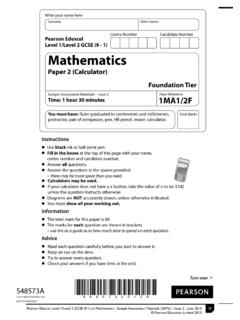Transcription of Guidance on preparing students for 'stretch and …
1 Guidance on preparing students for ' stretch and challenge' in the revised A2. assessments June 2009. QCA/09/4299. Guidance on preparing students for ' stretch and challenge' in the revised A2 assessments Contents 3. Implications of the changes for teaching and learning .. 4. 4. Mark 4. The A* 5. Examples .. 6. 2009 Qualifications and Curriculum Authority] 2. Guidance on preparing students for ' stretch and challenge' in the revised A2 assessments Background The current GCE A level specifications were revised for first teaching in 2008. A key part of these revisions was to introduce ' stretch and challenge' into A2 assessments to prepare students better for the skills required in higher education and employment. The awarding bodies were given Guidance that ' stretch and challenge' questions should: use a variety of stems in questions for example analyse, evaluate, discuss, compare.
2 To elicit a full range of response types, thereby avoiding a formulaic approach ensure that sections of questions are connected, thereby avoiding questions that are too atomistic require extended writing in all subjects use a wider range of question type to address different skills, ie not just short answer and structured questions, but open-ended questions, case studies, etc use improved synoptic assessment in all A2 assessments. There is now a more consistent approach to the assessment of the quality of written communication. This is assessed in questions requiring extended writing. Ideally these questions will be assessed using levels of response mark schemes with quality of written communication descriptors integrated into the mark bands. Achievement on ' stretch and challenge' will be recognised, rewarded and reported through an additional A* grade. The A* grade will be awarded for the A level qualification only (not for the AS qualification or at unit level).
3 The A* grade will be awarded to candidates who have achieved: a grade A overall (ie 80% of the maximum uniform marks for the whole A level qualification). 90% of the maximum uniform marks on the aggregate of the A2 units. 2009 Qualifications and Curriculum Authority] 3. Guidance on preparing students for ' stretch and challenge' in the revised A2 assessments Implications of the changes for teaching and learning Teachers will need to scrutinise carefully the sample assessments and mark schemes (for both internal and external assessments) to identify what changes have been made in their subject specification. Questions Points to note: In some subjects, there may be question stems that were not used previously, eg 'discuss', 'assess', and these will require some extended writing and may be marked using levels of response mark schemes. (See example 1.). In some subjects, there may be new longer essay style questions.
4 (See example 2.). All A2 units will contain some synoptic assessment. Mark schemes Points to note: 'Describe' and 'explain' questions may continue to be point marked but there may be restrictions, eg one mark for each point made and then additional marks for expansion of the point. This will encourage and reward in-depth answers. (See example 3.). 'Discuss' questions will usually be marked using levels of response / banded mark schemes. students may be required to assess the pros and cons and present and justify an argument to achieve full marks. (See examples 1 and 4.). Synoptic assessment will be a part of all A2 units and so students will need to be prepared for this. (See examples 4, 5 and 6.). There may be increased demand in the top mark bands of levels of response mark schemes. (See example 4, 5 and 6.). The changes to the assessment of quality of written communication mean that candidates will achieve full marks on some questions/tasks only if they have good quality of written communication.
5 (See examples 4, 5 and 6.). 2009 Qualifications and Curriculum Authority] 4. Guidance on preparing students for ' stretch and challenge' in the revised A2 assessments The A* grade The introduction of the A* grade may change resitting behaviour of some high-ability candidates. students who are comfortably on target to achieve a grade A and are aiming to achieve an A* would be better advised to concentrate on their A2 units than to resit AS units in order to maximise their uniform marks. 2009 Qualifications and Curriculum Authority] 5. Guidance on preparing students for ' stretch and challenge' in the revised A2 assessments Examples The following have been selected from the awarding bodies' sample assessments for the revised A. levels to illustrate the points to note in the new examinations. Example 1 OCR computing unit F453. Question 3a) Discuss the use of different computer architectures for different problem solutions.
6 Mark scheme High level response [6-8 marks]. Candidates will show a clear understanding of the problem and answer the question. Candidates will accurately and clearly, as a minimum give both positive and negative implications and a discussion will take place. The information will be presented in a structured and coherent form appropriate to a discussion. There will be few if any errors in spelling, grammar and punctuation. Technical terms will be used appropriately and correctly. Medium level response [3-5marks]. Candidates will show an understanding of the problem and may answer the question from one viewpoint only. Candidates may only give either positive or negative implications. The information will be presented in a structured format appropriate to a discussion. There may be occasional errors in spelling, grammar and punctuation. Technical terms will be mainly correct.
7 Low level response [0-2 marks]. Candidates may demonstrate a limited understanding of the problem. Information may be a list of points, with no implications. Information will be poorly expressed and the presentation of the information may not be appropriate for a discussion. There will be a limited, if any, use of technical terms. Errors of grammar, punctuation and spelling may be intrusive. Points to be made: Von Neumann architecture involves the use of data and instruction being held together in memory sequential processing involves the use of a sequence of instructions carried out in a specific order to solve a problem following a specific algorithm where the order will change the outcome suits any example where the outcome is dependent on steps being taken in a defined order eg the solution to a formula necessarily time hungry because it uses a single processor parallel processing uses multiple processors to carry out instructions at the same time requires complex processing to adapt the sequential algorithm speeds up arithmetic processes mention of co-processing mention of array processing used in time dependent operations which require large amounts of processor time eg weather forecasting explanation of interdependency of conditions in physical blocks 2009
8 Qualifications and Curriculum Authority] 6. Guidance on preparing students for ' stretch and challenge' in the revised A2 assessments Example 2 AQA biology unit 5. Question 11 Write an essay on one of the following topics. EITHER (a) Mean temperatures are rising in many parts of the world. The rising temperatures may result in physiological and ecological effects on living organisms. Describe and explain these effects. OR (b) The causes of variation and its biological importance. You should write your essay in continuous prose. Your essay will be marked not only for its scientific accuracy, but also for your selection of relevant material from different parts of the specification. The maximum number of marks that can be awarded are Scientific content 16. Breadth of knowledge 3. Relevance 3. Quality of written communication 3. General principles for marking essay questions Four skill areas will be marked: Scientific content (S).
9 Breadth of knowledge (B). Relevance (R). Quality of written communication (Q). These skill areas are marked independently of each other. Providing that there is sufficient evidence, and the subject content is relevant to the question answered, it is possible for candidates to obtain maximum credit for skill areas B, R and Q, even if they gain little credit for scientific content. The following descriptors will form the basis for marking. Scientific content (Maximum 16 marks). Mark Descriptor 16 Material accurate and of a high standard throughout, reflecting a sound understanding of the principles involved and a knowledge of factual detail fully in keeping with a programme of A level study. In addition, there are some significant references to material which indicates greater depth or breadth of study. 14. 12 Most of the material is of a high standard reflecting a sound understanding of the principles involved and a knowledge of factual detail generally in keeping with a programme of A level study.
10 Material accurate and free from fundamental errors, but there may be minor errors which detract from the overall accuracy. 10. 8 A significant amount of the content is of appropriate depth. Shows a sound understanding of most of the principles involved and a knowledge of factual detail generally in keeping with a programme of A-level study. Most of the content is accurate with few fundamental errors. 6. 4 Material presented is largely superficial with only occasional content of appropriate depth. Shows some understanding of some of the basic principles involved. If a greater depth of knowledge is demonstrated, then there are many fundamental errors. 2. 0 Such material as is relevant is both superficial and inaccurate, rarely demonstrating evidence of knowledge in keeping with a programme of A level study. 2009 Qualifications and Curriculum Authority] 7. Guidance on preparing students for ' stretch and challenge' in the revised A2 assessments Breadth (Maximum 3 marks).











